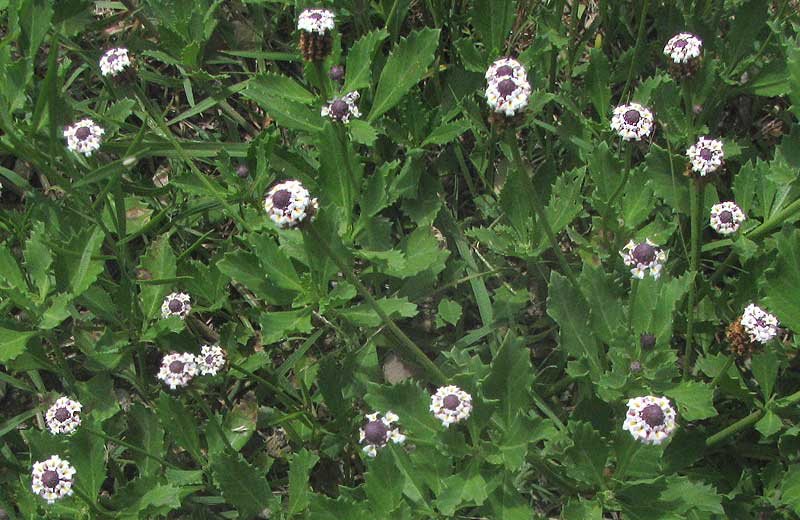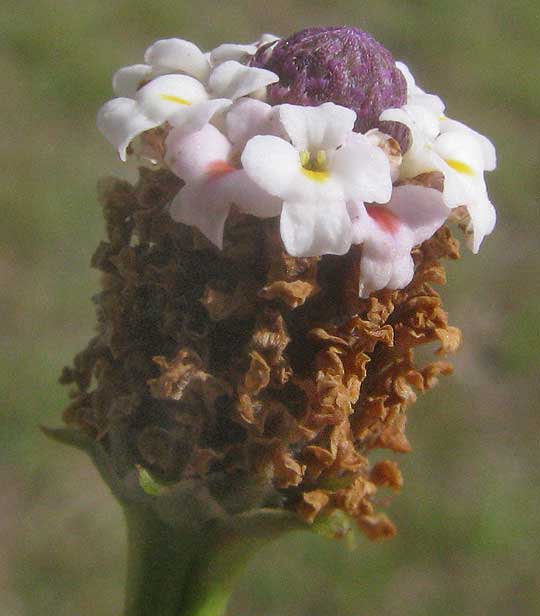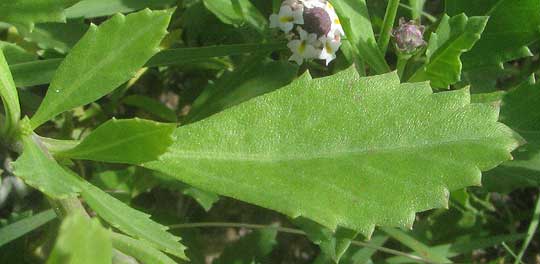Excerpts from Jim Conrad's
Naturalist Newsletter

from the July 7, 2013 Newsletter issued from the Frio Canyon Nature Education Center in the valley of the Dry Frio River in northern Uvalde County, southwestern Texas, on the southern border of the Edwards Plateau; elevation ~1750m (~5750 ft); N29.62°, W99.86°; USA
FOGRUIT/ FROGFRUIT
We're in the midst of a long drought here but we did get a good rain a couple of weeks ago, so now the landscape is fairly green and certain wildflowers that have held back during the spring now are flowering. One very common weedy plant growing in hard-packed soil along roads and similar disturbed areas is the ankle-high, mat-forming plant with pea-sized flowering heads shown at the top of this page.

Above, a close-up of a flowering head shows that the individual flowers bear four corolla lobes, the top and bottom ones being larger and slightly different in shape from the side ones, so that the corollas are somewhat bilaterally symmetrical. The flowers' corolla throats at first are yellow but as they age they turn reddish. In the picture, peeping from the throat of the flower facing us you can see two of the flower's four anthers.
Below the line of flowers encircling the top of the flowering head, the brown, shriveled items are old corollas of flowers already pollinated. Above the circle of flowers, the purplish "dome" consists of overlapping bracts, or modified leaves, beneath each of which lies an immature flower. When the current flowers are pollinated and their white corollas shrivel and turn brown, new flowers will emerge just above them, from beneath their respective bracts. This will cause the region of brown, shriveled corollas below to elongate while the purple dome will become a little lower. The immature head starts out more or less spherical and purple, but ends up long and brown, with fruits maturing beneath the layer of brown, shriveled corollas.
This unusual combination of field marks is diagnostic of a certain very common, easy to recognize genus of plants in the Verbena or Vervain Family, the Verbenaceae: the genus Phyla. Plants in the genus Phyla are normally referred to as fogfruits or frogfruits, and I wish I knew how the genus got stuck with those two names. Wildflower.Org's "Ask Mr. Smarty Plants" page says that the name fogfruit probably predates frogfruit by about 100 years (early 1800's for fogfruit vs. early 1900's for frogfruit), and the expert visualizes a wildflower book editor a long time ago making an error.
The various species of fogfruit/frogfruit/genus Phyla --of which about seven are listed for North America -- can be hard to distinguish. In Uvalde County two species are commonly encountered and two more might turn up here. Ours keys out to -- and matches photos on the Internet of -- PHYLA FRUTICOSA, commonly listed in wildflower books as the Diamondleaf Fogfruit.
Our Diamondleaf Fogfruit is a mostly tropical American species extending into the US in Texas, Louisiana, a bit of New Mexico, and southern Florida. It's become a weedy invasive in several countries in other parts of the world.
The main field mark distinguishing it from other species is that its leaves are widest at about their middles, not toward their outer ends, and the leaves' teeth normally begin in the lower half of the leaf, again not on the outer end. A typical Diamondleaf Fogfruit leaf is shown below:

Older books often assign Phyla species to the genus Lippia.